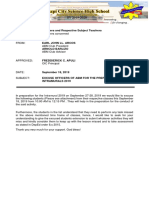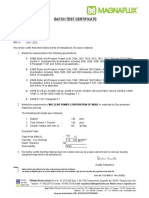Physics: Performance Task On Measurements
Uploaded by
brentngoPhysics: Performance Task On Measurements
Uploaded by
brentngoBrent Ngo H4H #21
Physics Performance Task # 1 Measurements
July 25, 2013 Mr. Pineda
Consumer Welfare Magazine Philippines Incorporated: An Analysis on the Validity of the Amount of the Product as Declared by the Producers Problem Some consumers think that they are being cheated by producers by putting less of what is really told of them. They are afraid that what they get is less than what they paid for. The real question here is: Are the amount/weight of different products consistent with what the producers are declaring? Hypothesis If we were to measure different brands of chocolate bars using a digital balance, then it should be consistent with the amount/weight written on the label (declared by the producers). Materials Used The following materials are to be used for the experiment. 1. digital balance 2. plastic container (where the chocolate bar will be placed for weighing) 3. 2 brands of chocolate bar - KitKat and Hersheys Treats (3 of each, for 3 trials)
plastic container
3 Bars of Kitkat (3 trials)
3 Bars of Treats (3 trials)
Procedure Procedures: 1. Weigh the plastic container. Take note of the weight. (The plastic container should be empty and clean. Any variable such as left over chocolate or water can also affect the result.) 2. Remove the chocolate bar from the wrapper. (The wrapper might affect the weight of the product being measured.) 3. Put the chocolate bar on the plastic container and record the weight each time it was measured. The weight of the plastic container must be subtracted form the result to get the original weight of the chocolate bar. 4. Repeat the process thrice for both brands. 5. Fill out the chart and compare it with the declared standard.
Treats Data Table Weight of the Plastic Container: 15.22 0.01 g
Hersheys Treats: Choco Roll mass (g) Declared Weight Trial 1 Trial 2 Trial 3 16 g 16.81 0.01 g 16.80 0.01 g 16.76 0.01 g
KitKat
Nestles KitKat mass (g) 17 g 18.53 0.01 g 18.58 0.01 g 18.55 0.01 g
Analysis The weight of the chocolates bars were acquired when the weight of the plastic container was subtracted from the one that appeared on the digital balance. Based on the results, the measurements are quite close to each other (for both brands). They were precise but not quite accurate. For Hersheys Treats: Choco Roll, the original weight is 16 g. According to the results of the experiment, they provided the consumers with more than what is declared by .81 0.01 g, .80 0.01 g and .76 0.01 g respectively for all three trials. Same with Nestles KitKat, they gave more than what is bought. The original weight is 17 g, and it exceeded by 1.53 0.01 g, 1.58 0.01 g and 1.55 0.01 g for the trials. Both companies gave more than what is expected, but one gave more than the other. They might have done this to increase their sale. If people knew that they give more, consumers would appreciate it more. The declared amount might just also be a limit, since none of the results were lower than the declared amount. It would also cost the companies more if they were to change declared weight for each of the wrapper. They could also be approximations of what the consumers should expect. Different conditions, may also have changed the weight (under very hot temperature resulting to melting). Conclusion Based on the experiment, the companies give more than what is declared. The amount/weight on the label is most probably an approximation. It will give the consumers an idea of how much they are paying for. The weight/amount varies from each and every product even if the brand is the same or not. The declared amount can also serve as a limit for the producers. Recommendations The producers can add the absolute uncertainty to the wrappers of their products to tell the consumers that it is just a mere estimation of what they are buying for. The producers can also be more accurate the next time they produce something else. They could measure their ingredients/products properly so as not to exceed over what is expected.
You might also like
- Physical Science Quarter 2 Module 9 Dual Nature of ElectronsNo ratings yetPhysical Science Quarter 2 Module 9 Dual Nature of Electrons33 pages
- SSG (747-8) General Pre-Flight Checklist From Cold & Dark V1.2No ratings yetSSG (747-8) General Pre-Flight Checklist From Cold & Dark V1.210 pages
- DLP - Basic Cal - Q4 - WK1 - April 1-April4 - DayritNo ratings yetDLP - Basic Cal - Q4 - WK1 - April 1-April4 - Dayrit7 pages
- The Impact of Intramurals On Young Adolescents Louis L. WarrenNo ratings yetThe Impact of Intramurals On Young Adolescents Louis L. Warren7 pages
- 11-STEM-Villa - Consolidated Grade SheetNo ratings yet11-STEM-Villa - Consolidated Grade Sheet4 pages
- Physical Education and Health 4 LearningNo ratings yetPhysical Education and Health 4 Learning2 pages
- General Direction: Read and Analyze The Items Below and Circle The Letters of The Correct AnswerNo ratings yetGeneral Direction: Read and Analyze The Items Below and Circle The Letters of The Correct Answer3 pages
- SHS E Class Record 11 RUIZ STEM 2 PRE CALCULUSNo ratings yetSHS E Class Record 11 RUIZ STEM 2 PRE CALCULUS1 page
- Triangles: TLE Grade 7 Learning Activity SheetNo ratings yetTriangles: TLE Grade 7 Learning Activity Sheet3 pages
- Department of Education: Republic of The PhilippinesNo ratings yetDepartment of Education: Republic of The Philippines3 pages
- General Physics 1: Vectors and Vector AdditionNo ratings yetGeneral Physics 1: Vectors and Vector Addition47 pages
- Non-Perfect Square Trinomial (Non - PST) : FactoringNo ratings yetNon-Perfect Square Trinomial (Non - PST) : Factoring18 pages
- Department of Education: Republic of The PhilippinesNo ratings yetDepartment of Education: Republic of The Philippines4 pages
- De Juan, Joshua G. PE Q2 Module 6 Be Involved! Be Fit and Healthy!No ratings yetDe Juan, Joshua G. PE Q2 Module 6 Be Involved! Be Fit and Healthy!6 pages
- Jesus L. Huenda, Is Coined From The Popular Filipino Checkerboard Game of Dama, (Or Lady in100% (3)Jesus L. Huenda, Is Coined From The Popular Filipino Checkerboard Game of Dama, (Or Lady in25 pages
- NLC Mathematics 9-10 Intervention RB v.1No ratings yetNLC Mathematics 9-10 Intervention RB v.180 pages
- Health Optimizing Physical Education 1: 2 QuarterNo ratings yetHealth Optimizing Physical Education 1: 2 Quarter10 pages
- College of St. John - Roxas: ACTIVITY SHEETS (WEEK 2-Methods of Philosophizing)No ratings yetCollege of St. John - Roxas: ACTIVITY SHEETS (WEEK 2-Methods of Philosophizing)3 pages
- A Survey of Indoor Air Quality Studies in The Philippines PDFNo ratings yetA Survey of Indoor Air Quality Studies in The Philippines PDF4 pages
- Packaging Sustainability: Tools, Systems and Strategies for Innovative Package DesignFrom EverandPackaging Sustainability: Tools, Systems and Strategies for Innovative Package DesignNo ratings yet
- Encased Stone Column With Different Modulus Elasticity of The Geotextile100% (1)Encased Stone Column With Different Modulus Elasticity of The Geotextile24 pages
- DIFFERENTTYPESOFWINGLETSANDTHEIRCORRESPONDINGVORTICESNo ratings yetDIFFERENTTYPESOFWINGLETSANDTHEIRCORRESPONDINGVORTICES23 pages
- Get Architecture Animal Human The Asymmetrical Condition 1st Edition Cather Ingraham free all chapters100% (1)Get Architecture Animal Human The Asymmetrical Condition 1st Edition Cather Ingraham free all chapters87 pages
- Journal of Robotics - 2021 - Neira - Review On Unmanned Underwater Robotics Structure Designs Materials SensorsNo ratings yetJournal of Robotics - 2021 - Neira - Review On Unmanned Underwater Robotics Structure Designs Materials Sensors26 pages
- Objectives of Indian Association For Medical InformaticsNo ratings yetObjectives of Indian Association For Medical Informatics2 pages
- Batch Test Certificate: Notes: 2. Form No: F/QC/008/1 3 Rev: 05/2022No ratings yetBatch Test Certificate: Notes: 2. Form No: F/QC/008/1 3 Rev: 05/20221 page
- ANSYS CFX-Solver Manager Users Guide PDFNo ratings yetANSYS CFX-Solver Manager Users Guide PDF192 pages
























































































